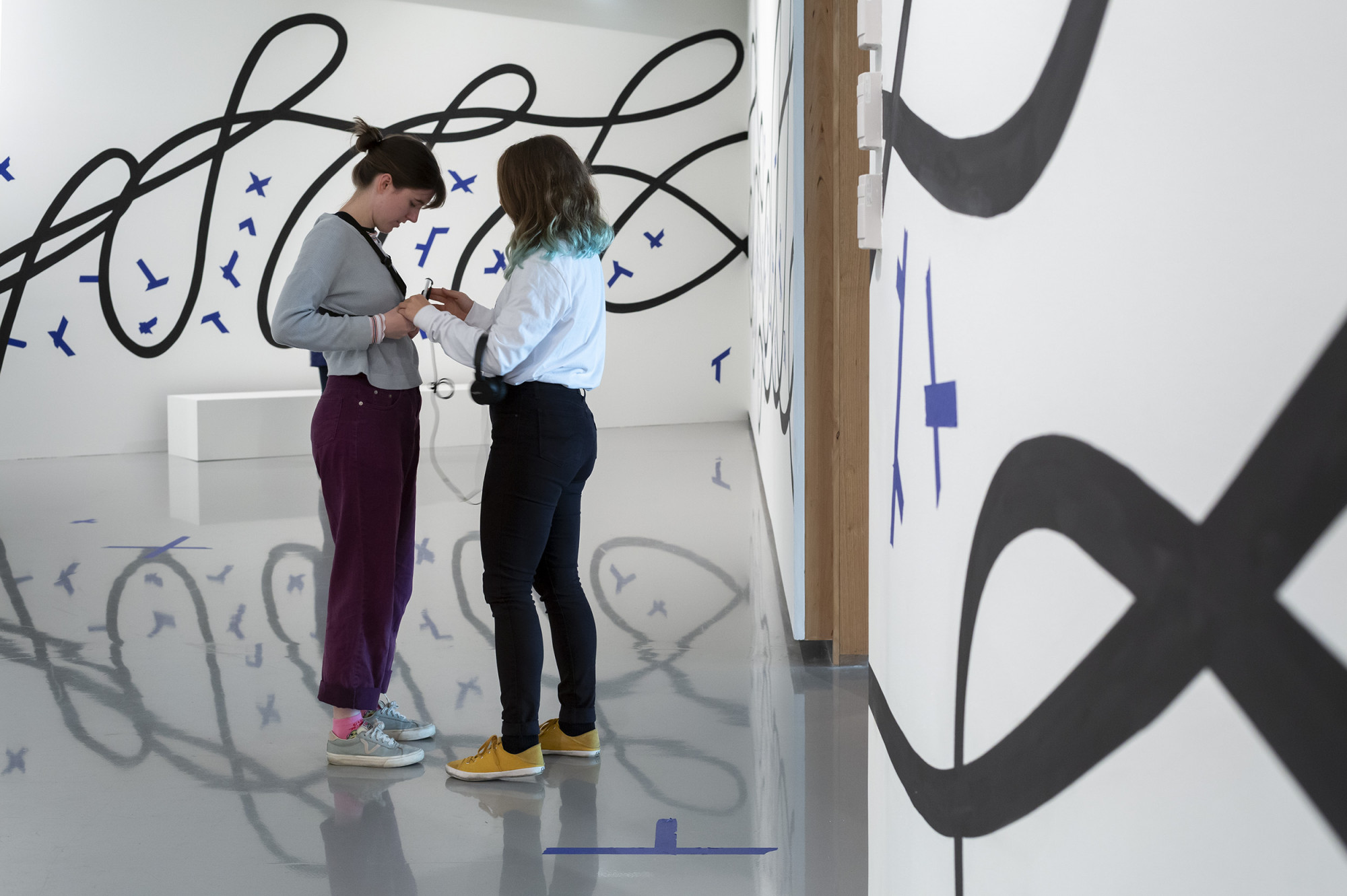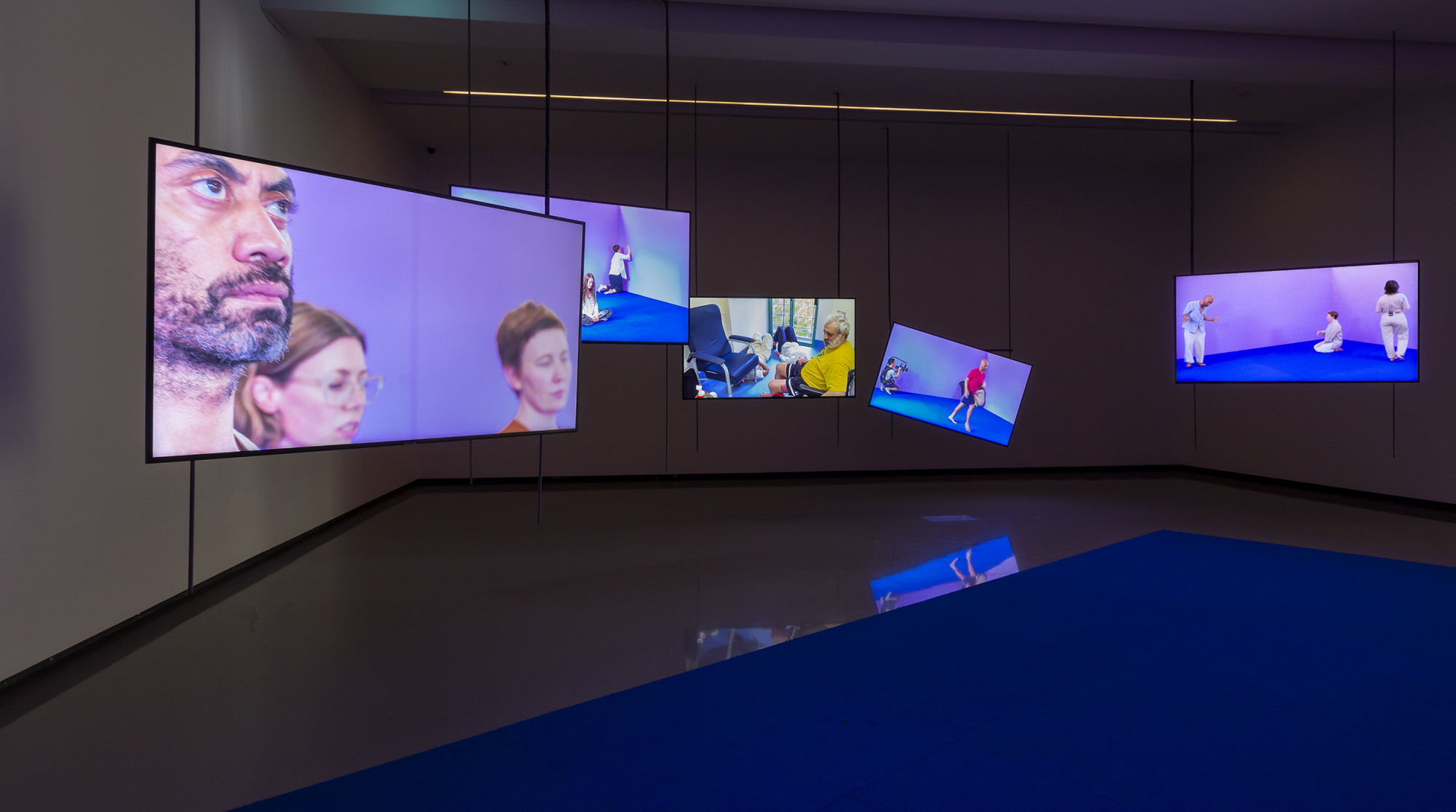Agatha Gothe-Snape, The Outcome is Certain
Amelia Wallin
“If art keeps good time”, writes Claudia La Rocco, “it keeps us in the present. It’s present”. This statement names precisely the experience of encountering Agatha Gothe-Snape’s recent survey exhibition The Outcome is Certain at Monash University Museum of Art (MUMA). The artist’s close attention to material and relational contexts, as well as the immediate context of the institution, emphasise the specificity of experience and the body as conduit. Curated by Hannah Mathews, the expansive exhibition brings together more than a decade of work, highlighting Gothe-Snape’s dizzying range of production and also her reoccurring methods of collaboration, text, improvisation, performance, duration, language and colour.
Wet Matter, a new commission by MUMA and the Institute of Modern Art in Brisbane, brings together both new and familiar strategies in the artist’s practice. Experienced entirely in relation to the body, Wet Matter transformed the gallery space into a receptacle for and of sounds. The work is mediated by an assistant, similar to prior works of Gothe-Snape’s, including Lion’s Honey (2019) and Beside Remains (2014). In each of these works, the gallery invigilator is an active agent in the experience of the work, and key to the context of the encounter.

Gothe-Snape has often worked with live encounters and unwieldy digital mediums, such as her PowerPoint presentation series, which has been continued since 2008, and is subject to the instability of system updates and software upgrades. For Wet Matter, Gothe-Snape incorporates technologies so new that both the audio introduction and the assistant forewarn of their potential failure.
Strapped into a custom harness from which a smart phone points outward, the participant navigates and activates aural spaces through themobile application. Described as a “locational audio experience”, the app, Sounds in Space, locates sound in relation to visual cues. Through a multi-day workshop, the sonic, textual and visual materials were produced with Gothe-Snape’s long-term collaborators Brian Fuata, Lizzie Thompson, and new collaborators Evelyn Ida Morris and Tea Uglow from Creative Lab.

A “wall drawing” of looped calligraphy occupies the visual field, and architectural interventions in the form of empty stages and platforms invite occupation. On the wall are rough crosses of blue painter’s tape, which I later learn where included to provide the software with more visual language to “read”. The calligraphy is a hommage to the artist’s paternal grandmother Margot Snape, a calligrapher, book maker and astrologist.
“Vagueness is the content and you are the form”, a voice speaks into my headphones as I wait, as instructed, at the threshold of the space. Once I enter and move through the space, I slip between voices and vocal textures, between monologues and phrases. The experience is not dissimilar to being inside a performance warm-up, with individual voices coming together as an ensemble. I listen to text about motherhood, cruising, time, books, as well as vocalisations, chanting, singing. At times I feel as though I am listening to myself think. Gothe-Snape, in an interview with Anneke Jaspers, refers to the “the sticky act of listening”. Voices stick to the air, uncovered by the body’s progression around the space.

Tracing circuits of influence and meaning within the artistic canon, Gothe-Snape examines the dissemination and consumption of knowledge. Intergenerational and familial inheritances frequently play out across the artist’s work; she regularly references her parents, her collaborators and her artistic community. Eight works from Gothe-Snape’s series Every Artist Remembered are included in the exhibition. Equal parts improvisation and systemisation, these works draw from a two-hour conversation between Gothe-Snape and a participant, who together list every artist they can remember. Names from Sydney’s artistic community are recorded alongside names such as Pablo Picasso and Meirle Laderman Ukeles. Although memory is imprecise and unreliable, each portrait is beautifully specific to a time and place. Positioned in close proximity is 24. Heavy Reading, 2013 AGS.ppsx (2013) and Living Sculpture (White) (2013), two intertwined works that reference the artistic influence of Australian sculptors, including her father, Michael Snape. Gothe-Snape maintains a long-standing interest in reorienting the aesthetics of late modernism through the relations of the body. Selective Memory (2019) consists of a wall painting, a minimalist sculpture painted in chroma key green and two monitors. Due to the exact shade of green the sculptures aren’t rendered as visible in the monitors, and the audience sees only themselves in space. In my case, my green socks also disappeared.

Gothe-Snape’s hugely productive body of work demonstrates acute attention to the conditions of art making. The artist attends to both the immediate context of the body in the space of the gallery and the contexts from which her practice arose. After spending time with each work, I return to Wet Matter before leaving: there was something spoken about motherhood and oceans that gives me a great moment of passing clarity. I try to return to it, retracing my steps through the space. I can’t find it, but it sticks.
Amelia Wallin is an Australian curator, researcher and writer. Her work centers on commissioning and facilitating cross-disciplinary artistic exploration, as well as interrogating alternative models for institution building. Her recent research and writing examines reproductive labour in the space of the contemporary art institution. Amelia has held curatorial and administrative positions at multi-arts venues, independent spaces, producing organisations, and Biennales in Sydney and New York. She joined West Space as Director in 2019.


